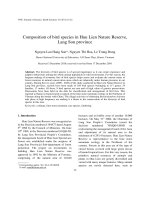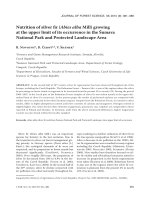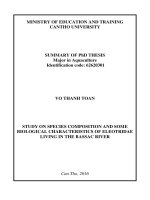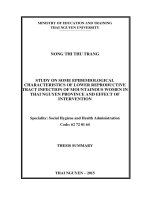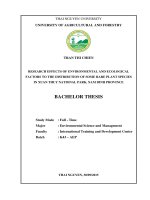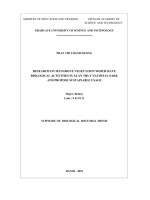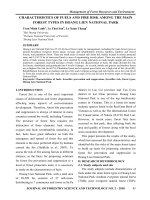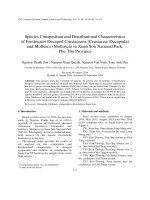Research on some main characteristics of natural forest in hoang lien national park lao cai province
Bạn đang xem bản rút gọn của tài liệu. Xem và tải ngay bản đầy đủ của tài liệu tại đây (8.31 MB, 62 trang )
MINISTRY OF AGRICULTURE AND RURAL DEVELOPMENT
VIETNAM NATIONAL UNIVERSITY OF FORESTRY
STUDENT THESIS
RESEARCH ON SOME CHARACTERISTICS OF NATURAL FOREST IN
HOANG LIEN NATIONAL PARK - LAO CAI PROVINCE
Major: Natural Resources Management
Code: D850101
Faculty: Forest Resources and Environmental Management
Student:
Bui Doan Mai Anh
Student ID: 1253090001
Class: K57 Natural Resources Management
Course: 2012 - 2016
Advanced Education Program
Developed in collaboration with Colorado State University, USA
Supervisor: Dr. Ha Quang Anh
Ha Noi, Oct 2016
1
ACKNOWLEDGEMENTS
This report is submitted for the Advanced Education Program Developed in
collaboration with Colorado State University, USA, faculty of Forest Resources and
Emvironmental Management, Vietnam Natural University of Forestry. This study would not
have been possible without the kindness help of many individuals and institutions. Most
importantly, I am very grateful to my supervisor Dr. Ha Quang Anh for his guidance,
instruction, and encouragement at every step of my study and for sharing his knowledge and
ideas with me.
I would like to thank Hoang Lien National Park (NP), Science and International
Cooperation Department of the NP with many good people who provide documents and go to
the field survey with me.
2
ABSTRACT
This study contributed findings of some main characteristics of natural forest in high
zone vegetation in Hoang Lien National Park included trees floors, regenerated trees and
shrubs, fresh vegetation floors. Based on the research objectives, a study decision used
fieldwork methods and some document from the publications and files of different agencies
combined with calculate by formula of excel software and SPSS to find the result about
characteristics of vegetation above 2700m elevations. From that, the study will proposed
measures served to forest management; improve efficiency for the protected forests.
3
TABLE OF CONTENT
ACKNOWLEDGEMENTS
ABSTRACT
TABLE OF CONTENT
APPENDIX
LIST OF TABLE
LIST OF FIGURE
ABBREVIATION
CHAPTER 1. INTRODUCTION ........................................................................................... 1
CHAPTER 2. GOALS, CONTENTS AND STUDY SITES ................................................... 4
2.1. Goals and specific objectives:.......................................................................................... 4
2.2. Study sites: ...................................................................................................................... 4
CHAPTER 3. METHODS ..................................................................................................... 8
3.1. Collecting data: ............................................................................................................... 8
3.1.1. Secondary data colection: ............................................................................................. 8
3.1.2. Fieldwork methods: ...................................................................................................... 8
3.3. Classification vegetation system of Hoang Lien NP: ..................................................... 15
CHAPTER 4. RESULTS ..................................................................................................... 17
4.1. Forests structure characteristics of trees stories: ............................................................. 17
4.1.1. Structural composition and density: ............................................................................ 17
4.2.2. The distribution rule of forest stand: ........................................................................... 20
4.3. Structural characteristics of regeneration stories: ........................................................... 26
4.3.1. Structure composition and density of tree regeneration: .............................................. 26
4.3.2. Origins regeneration: .................................................................................................. 27
4.3.3. Density regeneration by qualities: ............................................................................... 28
4
CHAPTER 5. DISCUSTION ............................................................................................... 30
5.1. Results analyzed field data: ........................................................................................... 30
5.1.1. Structural composition and density: ............................................................................ 30
5.1.2. The distribution rule of forest stand: ........................................................................... 31
5.1.3. Structural characteristics of regeneration stories: ........................................................ 32
5.2. Factors affecting the forest vegetation: .......................................................................... 34
5.3. Propose some measures to conserve natural resources: .................................................. 34
5.3.1. Planning for conservation and sustainable development Hoang Lien NP: ................... 34
5.3.2. To raise awareness about natural resource management and forest protection laws: .... 35
5.3.3. Economic development, increasing income for the community: .................................. 35
5.3.4. Strengthen management and protection: ..................................................................... 35
5.3.5. Make well the task of forest fire prevention and fighting: ........................................... 36
5.3.6. Strengthening the scientific research activities and international cooperation: ............. 36
5.3.7. Population Stabilization:............................................................................................. 36
5.3.8. Solution silviculture: .................................................................................................. 36
CHAPTER 6. CONCLUSION ............................................................................................. 38
REFERENCE ...................................................................................................................... 39
APPENDIX
5
LIST OF TABLE
Table 4.1. Composition and density of the IA2d forest status of San Sa Ho commune ............ 17
Table 4.2. Composition and density of the VB2 forest status of San Sa Ho commune ............. 19
Table 4.3. Modeling results distribution N / D1.3 with theoretical functions ............................. 20
Table 4.4: Modeling results distribution N / H with theoretical functions ................................ 22
Table 4.5. Correlation equation H/D1.3 by Linear and Logistic functions in IA2d forest status ....... 24
Table 4.6. Correlation equation H/D1.3 by Linear and Logistic functions in VB2 forest status .... 25
Table 4.7. Composition and density of tree regeneration ........................................................ 26
Table 4.8. Tree regeneration sources ..................................................................................... 28
Table 4.9. Tree regeneration by qualities ............................................................................... 29
6
LIST OF FIGURE
Picture 2.1. Administration Map of Hoang Lien National Park, Lao Cai Province .................. 5
Figure 4.1 Charts simulated the distribution rule N / D 1.3 in IA2d forest status ..................... 21
Figure 4.2. Charts simulated the distribution rule N / DBH in VB2 forest status ................... 21
Figure 4.3. Charts simulated the distribution rule N /H in IA2d forest status......................... 23
Figure 4.4. Charts simulated the distribution rule N /H in VB2 forest status ......................... 23
Figure 4.5. Correlation equation H/D1.3 in IA2d forest status ................................................ 25
Figure 4.6. Correlation equation H/D1.3 in VB2 forest status ................................................ 26
Figure 4.7. Regeneration density by species ......................................................................... 27
Figure 4.8. Regeneration density by sources ......................................................................... 28
Figure 4.9. Regeneration density by qualities ....................................................................... 29
7
ABBREVIATION
NP: National Park
SP: Standard plot
OS: Other species
IV: Important value
DBH or D1.3m: Diameter at Breast Height
8
CHAPTER 1. INTRODUCTION
Forest are valuable resources, there is an important role for the national economy.
Vietnam’s forests have basic characteristics of tropical forests, with high biological diversity
and large biomass.
People study and see the forest as an ecosystem that has the characteristics and special
structures. Forest structure is the internal reorganization of the component organisms in forest
ecosystems through which the species has different ecological character can live in harmony
and achieve relative stability. “Forest structure is not only the result but it also the expression
of relations of struggle and mutual adaptation between forest biological and ecological
environment among each other woodland creatures” (Ngo Quang De 1992). In our country,
the study of forest structure mostly focused on object are plantation forests and protection
forests. The study of the structure and regeneration of the special-use forests still less. So the
solution to conservation of natural resources, biodiversity values in the area of special-use
forests lacking scientific basis, not really effective.
While, in the world, many researchers had research on natural forest structure.
"Features of the structure and natural regeneration have been many scientists around the
world conducting research to establish a scientific basis and theoretical work in service of
forest business. The study of the ecological structure of the rainforest was P. W. Richards
(1952), G. N. Baur (1964), E. P. Odum (1971) ... conducted. These studies have raised
perspective, the concepts and qualitative description of the composition, life forms and slab
floor of the forest. "(Luong Thi Thanh Huyen, 2009)
“Some typical projects of authors like Hara et al. (1978-1982), Kapos et al. (2000),
Rainer W. Bussmann (2006), JMNinot & A.Ferre (2008) ... These studies have focused on the
distribution of elevations zone on the basis of natural conditions, direction exposed terrain, ...”
(Truong Ngoc Kiem, 2014)
1
With Vietnam forest, the complexity show the clearest in the structure of the tree
species composition and second stories. The study of forest structure not only helps maintain
the stability of the forest ecosystem, conditioning the structure factors, but creates an
opportunity for managers to use and promote maximum sustainable benefits of forests for the
economy, society and environment. Therefore, one of the important issues to be studied is to
find out the rules of forest structure as a basis for proposing measures appropriate protect and
develop forest resources sustainably.
In Vietnam, “The adequate studies on the distribution of vegetation by elevation is not
much that often only one of the research content of flora.” (Truong Ngoc Kiem, 2014). The
essence of the elevation rule with local particular character depends on the foothills zone base
with other factors should in each region in the world have different projects related to this
rule. “Because of Vietnam’s hills differentiate continuously from north to south so territorial
differentiation is dominated very clear by elevations rules”(Truong Ngoc Kiem, 2014). Vu Tu
Lap (1976) divided into three zones: from 0 - 600m (internal zone foothills monsoon tropics,
including the sub zone), from 600 - 2.600m (sub tropical monsoon zone on the mountain,
including the sub zone ), Over 2.600m (temperate monsoon zone on the mountain). And, Thai
Van Trung (1978) divided the zone: tropical moisture (less than 700m in the north and to
100m in the south), subtropical low mountain downstairs (from 700m - 1600m in the north
and from 1000m - 1800m in the south ), warm temperate low mountains upstairs (from
1600m - 2400m in the north and from 1800m - 2600m in the south), cold temperate medium
mountains downstairs: over 2400m in the north and 2600m in the south.
Hoang Lien National Park (NP) was chosen as a center of diversity of plant species in
the conservation program of plant species of International Union for Conservation of Nature
(IUCN). National Park is also a global environmental fund is classified as A, the most senior
of the value of biodiversity in Vietnam, and Hoang Lien NP is recognized as ASEAN heritage
2
park. With ecosystem diversity are fauna and endemic, and have higher valuable research and
tourism Hoang Lien NP is becoming a great places for tourist and research.
However, due to the development of tourism and the exploitation forest products of
people, national park is in danger of being abused, primary forest area is about 30%, the rate
of forest degradation in alarming rate partly by further intervention and no plans of man.
Besides, due to the nature elevation, Hoang Lien NP is the only place in Vietnam with
temperate zone monsoon on the mountain (from 2700m).
Stemming from this reality, the topic "Research on some main characteristics of
natural forest in Hoang Lien National Park – Lao Cai Province" were made to contribute
additional information of natural forest structure in Hoang Lien NP. At the same time, the
research results is expected will be the basis of the proposed measures protection,
reforestation and some reasonable impact on forests in the study area in particular, and in
similar ecological zones Vietnam in general. To ạchieve that goal, this study will answer the
following questions: What is the structural characteristics of high zone vegetation of natural
forest in Hoang Lien NP? What is distribution rule and correlation between survey factors?
What are the factors affecting to the forest structure and biodiversity values? How can
protection and development of forests in Hoang Lien NP?
3
CHAPTER 2. GOALS, CONTENTS AND STUDY SITES
2.1. Goals and specific objectives:
- Goal: Addition knowledge about forest structure of high zone vegetation of natural
forest in Hoang Lien NP.
- Specific objectives:
+ To determine the forest structure composition of some natural forest status in the
research area.
+ To simulate distribution rule and correlation between some factors investigated.
+ To evaluate several factors affect on the forest growth and its structure.
+ To proposed some solutions to manage, protect and conserve natural resources for
Hoang Lien NP.
2.2. Study sites:
Hoang Lien NP, located in the Northwest region of Vietnam, Hoang Lien Mountains,
northwest of Sa Pa District, 36km from Lao Cai City and 350km from Hanoi, the
geographical location N 22 o09 '- 23o30' and E 103 o00’ - 103o 59’. The total area of land under
the management of Hoang Lien NP is 51.800 ha, including 29.845 ha core zone. About the
administrative boundaries, its located in 6 communes: San Sa Ho, Lao Chai, Ta Van, Ban Ho,
Muong Khoa and Than Thuoc belong to Sapa district in Lao Cai province and Than Uyen
district of Lai Chau.
4
Picture 2.1. Administration Map of Hoang Lien National Park, Lao Cai Province
Hoang Lien mountain range is a system of over 2000 m high peaks running from the
Northwest - Southeast. Especially, in the National Park with high peaks Fansipan 3.143m
compared to sea level, be likened to "roof" of Vietnam in particular and Indochina in general.
Most of the peaks has an average elevation of 2000 - 2500 meters, where the average was the
lowest of the Ban Ho Sapa is an elevation is 380m. Towards the south of the valley as flat,
broader and most ethnic minorities are used as terraces. The main types of terrain Hoang Lien
NP consists of high mountains, valleys and hill slopes.
In the core area of Hoang Lien NP, there are 04 main ethnic minorities (Mong, Dao,
Giay, Tay), scattered population, particularly has 5 villages in the core zone of the park, so the
propagation and dissemination awareness education for people is limited and staff were
5
difficult to travel, exchange exposure, guidance, inspection, monitoring and management of
forest protection. Mainly business practices of upland peoples is agricultural with rice
production forms on the narrow terraces. The phenomenon of shifting cultivation, slash and
burn agriculture have reduced the forest area quickly. Besides, forest fires, hunting of wild
animals for food and sold for money (skin, horns), medicinal have caused damage to the forest.
Along with other activities such as logging, firewood, forest products, pharmaceuticals, ... it has
become a threat to the risk of depletion of biodiversity and deforestation. The education, health
care and infrastructure system (roads, electricity, water ...) are difficult due to rough terrain and
population are not living concentrated. (Source: Hoang Lien National Park)
Overall, the life of the people is quite poor, labor surplus in unharvested season lead to
operate illegal forest exploitation continues, besides some people along the Hoang Lien NP
not quit living on forest practices and forest products harvesting, hunting animals. These are
major challenges for the management and conservation of the park. (Source: Hoang Lien
National Park)
With locations in the east of the Hoang Lien, complex terrain regional climate regimes
Hoang Lien NP is also strongly differentiated according to terrain elevation and direction.
One characteristic of the Hoang Lien's climate is almost all year round in wet conditions. The
average relative humidity of about 85%, monthly at least average rainfall well over 20-30
mm. The average air temperature in popularity index from 13-21°C, larger in western slopes,
smaller in eastern flank. The lowest temperature in December and January, many years to less
than 5°C. In winter every year with frost and snow can sometimes below -3°C. Because there
are no data on meteorology in areas where higher elevations Sa Pa, but it can be said that the
climate gets higher as heat tends to decrease. At an altitude of over 3000 meters, according to
the data measured by the survey team, the average temperature is 12°C or only lower in the
summer (June) atop the air temperature in the range of 8 - 12oC. Uneven distribution of
6
rainfall between the months of the year, especially during the summer months, the relatively
high rainfall. The rainy season starts from mid-March to mid-October, two months are July
rainfall (454.3 mm) and August (453.8 mm). Humidity air is relatively high, about 86%
annual average. Biggest humidity month is September and November with a value of 90%,
especially in April Dry worth 82%. In addition to the general weather factors, there are also
special weather phenomena such as fog, frost, drizzle, thunderstorms, frost ...
The differentiation climate of Hoang Lien National Park very complicated, it is
characterized by many special elements, as well as the nature of the tropical, subtropical and
temperate. According to the research subjects " Assessment survey combined flora and
mammal surveys in the Hoang Lien National Park - Lao Cai Province", vegetation
overlay’s Hoang Lien National Park is classified under 3 main zones: Lower zones (<700m)
is classified as the Tropical monsoon while Middle zones (700m - 2,700m) is classified as
Subtropical monsoon on the mountain. The remaining zone is greater than 2700m where is
known as Temperate monsoon zone on the mountain.
In this study, natural forest on Temprate monsoon zone (>2700m) was considered as
my object of interest.
7
CHAPTER 3. METHODS
3.1. Collecting data:
3.1.1. Secondary data colection:
Secondary documents such previous relevant publications and reports were reviewed
in order to get an overview of my study interest in my study site.
Before going to the field, I reviewed documents (secondary data) from the
publications and files of different agencies, such as Vietnam National University of Forestry,
Hoang Lien National Park, some websites... to get better understanding about the site study,
the characteristics of local people and the content of what I was going to do. I found key
themes that have been explore and took note to compare with reality.
3.1.2. Fieldwork methods:
* Prepare tools and materials:
Before conducting fieldwork, should prepare some instruments and documents
relating follows: Measuring tape 30m, GPS, handheld locality, glass calipers, Blumeleiss,
balance springs, nylon bag, canvas bags, paint, tables and other documents.
* Collecting field data:
Based on topographic maps of the park, proceed to determine the boundaries altitudes
above 2700m follow contours, route surveys and survey sample plots established on the
typical plant communities. To study the full range of vegetation zones represent researching,
selecting research route, study sites are very important. Based on topographic maps and maps
of forest resources of the Hoang Lien National Park, conducted online survey route. On that
basis, the project has identified 1 route surveys: Xe Mountain - Fansipan route: This is the
tourist route conquer Fansipan located in San Sa Ho Commune, Sapa district, has a length of
11.2 km, the route starts from the Tram Ton (1900m) up to the top end is Fansiphang
(3.143m). This is the most typical representative route for the transformation of plants
8
according elevations, route have been hit hard by human travel activities, research projects set
the standard plot on remote locations line trail, where most little affected by humans.
Within the scope of research, set 3 standard plot (SP) with an area of 1000m2
(40m*25m). Each standard plot must specify the following information: location, forest
conditions, the process of measuring.
In standard plots, investigating the following criteria:
- In trees stories: Evaluation all plants in D1,3, has diameter larger than 6cm,
investigate details such as: D1,3, H, Dcanopy the growth situation.
+Note the data in table 1: trees stories survey:
Standard plot:
Investigator:
Area:
Investigated date:
Status:
ID
Coordinates:
Species
Height
DBH
Dcanopy
Note
- In regenerated trees stories:
+ Investigation regenerated trees: Each plot set 5 sub-plots: Four sub-plots at the four
corners of the standard plot and one sub-plot in the middle with an area of 5m * 5m. In subplot investigate under 6cm diameter trees with the following criteria: species name, height,
quality and origin of each tree regeneration.
+ Quality of each species was assessed on three level:
A - Good
Grow well, straight stem, canopy grow equally, no topless, no pests,
C - Bad
Not straight, topless, have pests
B - Medium
Between two types above
9
+ Note the data in table 2: regenerated trees stories survey
Standard plot:
Investigator:
Area:
Investigated date:
Status:
Number of
Coordinates:
No
Hight of trees
Source of
Species
sub-plot
Growth rate
(Species)
( cm )
reproduction
50 <50
>100
Seeds
Buds
A
B
C
100
1
2
The data measured in the field, before processing, analysis should be conducted to
calculate and check back to find errors in the process of recording.
3.2. Data analysis
a. For trees stories:
* Structure composition:
Composition ratio of each species (Standard plot) calculated according to the method
of Daniel Mamillod, Vu Dinh Hue (1984), Dao Cong Khanh (1996) through two indicators:
Ratio% density (N%) and basal area (G%). Each species is determined composition ratio IV%
(Important Value Index):
Where :
- N% is the relative abundance of species (i): calculated by taking the number of individuals
of species (i) divided by the total number of individuals of all species then multiplied by
100%.
10
- G% is the relative advantage of species (i): calculated by taking the total cross-sectional
body area at a height of 1.3 m of the tree species (i) divided by the total cross-sectional body
area at a height of 1.3 m of all trees were investigated and then multiplied by 100%.
Determination composition ratio of high story according to the formula:
A=
Where:
- A: composition ratio of high story
- m: number of individuals of each species in the SP
- n: the total number of trees in the SP
* Method simulation of the distribution law:
- Distribution distance:
Distribution distance is the probability distribution of the random variable intermittent
mathematical form:
In which γ and α are two parameters. Curves have distribution of distance as a peak to the
value x = 1 when γ + α <1. Distribution of distance is used to describe the distribution N / D1.3
empirical is top form as a shaped J. Participate the distribution of distances are estimated as
follows:
Where:
- f0 is the frequency corresponding to the first diameter (x = 0).
- n is the total number of trees of all sizes. When 1 - γ = α, the distribution of the
distance back to form geometric distribution.
11
If Di is the median diameter, Dmin is the smallest diameter, k is group distance, then xi is
defined as follows:
- Weibull distribution:
Is the probability distribution of continuous random variable with density function and
distribution function of the form:
Density function:
Distribution function:
With x ≥ 0
If using the Weibull distribution to simulate the distribution of tree diameter and height
(referred to as the quantity Y) is to be converted by the following variables:
Where: Ymin is the smallest diameter or height value in the range observed after being
adjusted data point.
- Distribution decreased Meyer type equations of the form:
Where Y is the observed frequency, X means the quantity of observations, α and β are two
parameters. In forestry, this distribution is often used to simulate the distribution of plants or
species (variable Y) according to diameter (variable X).
12
* Check the distribution law hypothesis
standards of Pearson:
standards based on a comparison between the frequency reasoning calculated according
distributions theory and experimental frequencies corresponding to each groups of the
quantity. It proved that, if H0 true and sample size large enough to compare frequency
distribution reasoning calculated according the organization theory in groups ≥ 5, then the
random variable:
Where:
with degrees of freedom k = m - 1, if the theoretical distribution have parameters
need to determined and k = m - r - 1, if there is r parameters need to estimate through
observation of the sample results.
If
calculated according
Check the table with k degrees of freedom, the
empirical distribution consistent with the theoretical distribution and vice versa.
* Research method correlation relationship between factors of forest investigation:
- The relationship between tree height and diameter at breast height (Hvn / D1.3). For
simulation correlation between height and diameter the scientists has used a lot of
mathematical equations form to simulate this rule, but with every tree that grows in different
conditions, it forms various mathematical equations. Thus when studying the relationship
between tree height with a diameter at breast height, the subject test with equation form:
logH = logk + b*logD1.3
* Testing the hypothesis of distribution law:
Hypothesis H0: Fx (x) = F0 (x), where F0 (x) is a distribution function is completely
defined. To test the hypothesis H0, people use appropriate standards when the square of the
Pearson:
13
Where: ft is the experimental values
flt is the theoretical values
If
Check the table with degrees of freedom k = m - r - 1 (r is the parameter of
the theory distribution need to estimate, m is the number groups after gross), the theory of
distribution matching empirical distribution (Ho +), vice versa, the theory of distribution not
matching empirical distribution (Ho -).
To facilitate the process of calculating and graphing distribution theory with
experiment, analyze the relationship H / D. Topics using Excel software and analyzed by
SPSS.
b. For regeneration stories:
* Organization of regeneration: The regeneration of plants is determined by the ratio
between the number of a certain species compared to the total number of species of plants in plot.
Composition was calculated using the formula:
Where: - Ki is coefficient of the species composition (i)
- Ni number of individuals species (i)
- N the total number of individual investigations
* Density of regeneration:
Regeneration density is determined by the formula:
Where: Ni: is number of trees of sub-plot (i) in the SP
Si: is area of sub-plot (i) in the SP
14
* Distribution of regeneration according to the height and level of quality
Statistics of regeneration according to 4-level height: <0.5m; 0.5-1m; 1-2m and over
2m. Drawing chart represents the number of plants regenerated by level height.
* The quality of regeneration
Research regenerated by level of good quality, medium and bad at the same time
determine the rate of regeneration plants promising to evaluate a general situation of the
regeneration taking place in the study area.
Proportion of good crops, medium, bad is calculated using the formula:
Where: - N% is the percentage of the tree good, medium or bad
- Ni total tree good, medium or bad
- N total regeneration
- Identify the potential regeneration: the trees with a height greater than the average
height of the shrub and good quality, medium
Percentage% of trees have prospects = (fi / n)×100
Where: fi: is number of trees have prospects
n: is number of trees.
3.3. Classification vegetation system of Hoang Lien NP:
Forest classification is a very important and considered as the very fundamental steps
for doing forest management. Hoang Lien National Park’s vegetation was classified into
different classes based on its characteristics following UNESCO’s system (1973) and Phan
Ke Loc (1985). These classification systems were presented as the following:
I. Closed forest formation layer.
IA. Mainly evergreen forest.
IA2. Formation group of evergreen rainforest monsoon.
15
IA2b. Formations evergreen rainforest monsoon in the low mountain.
IA2c. Formations evergreen rainforest monsoon in the medium mountain.
IA2d. Formations evergreen rainforest relative humidity in the high mountain (access Alpin).
IA2e. Formations tropical bamboo forests in lowland and low mountains.
II. Light forest formation layer.
III. Shrub formations class.
IIIA. Shrub mainly evergreen formations subclass.
V. Grasslands formations class.
VA. Grasslands high paddy forms formations subclass.
VA3. Tropical grasslands high paddy forms with shrubs and woodtrees.
VB5. Tropical grasslands high paddy forms without woodtrees.
VB. Medium grasslands paddy forms class.
VB2. Medium tropical grasslands paddy form with tree cover less than 10%, with or
without shrubs.
VB3. Medium tropical grasslands paddy form with shrubs without woodtree.
VC. Low grasslands class.
VD.Grasslands class without paddy form.
In the thesis, I had been survey 3 SP at 3 areas which are represent for 3 status, there are:
+) IA2d. Formations evergreen rainforest relative humidity in the high mountain
(access Alpin)
+) VB2. Medium tropical grasslands paddy form with tree cover less than 10%, with
or without shrubs.
+) VB3. Medium tropical grasslands paddy form with shrubs without woodtree.
16
CHAPTER 4. RESULTS
4.1. Forests structure characteristics of trees stories:
4.1.1. Structural composition and density:
4.1.1a. IA2d forest status:
Forest type in the region and reach the top of Fansipan peak, can be considered as
dominant forest Rhododendron and Tsuga dumosa. Rhododendron species grows almost pure
in canopy layer (A1layer), Tsuga dumosa species are growing rise above Rhododendron (A0
layer), look remotely like the dark blue hat located on the lawn. The other broad-leaved trees
are common here: Viburnum cordifolium, Eriobotrya, Illicium, Symplocos, Rhodoleia
championii...
From the survey data 1 SP, the species composition results are summarized in the
table below:
Table 4.1. Composition and density of the IA2d forest status of San Sa Ho commune
I
D
Species
N
DBH average
H average
(Tree/ha)
(cm)
(m)
N%
G
(m2/ha)
G%
IV%
1
Rhododendron
240
31.5
9.4
47.1
39.4
46.9
47.0
2
Tsuga dumosa
110
36.1
9.5
21.6
12.4
26.3
23.9
70
25.0
7.9
13.7
2.0
10.7
12.2
40
35.4
10.05
7.8
1.6
9.4
8.6
460
32.0
9.2
90.2
55.4
93.2
88.0
50
20.6
7.1
9.8
0.8
6.8
8.3
26.3
8.2
100
100
3
Viburnum
cordifolium
Lithocarpus
4
phansipanensis A.
Camus
Total 4 main species
Total 4 other species
Average
Total
510
56.2
100
17
